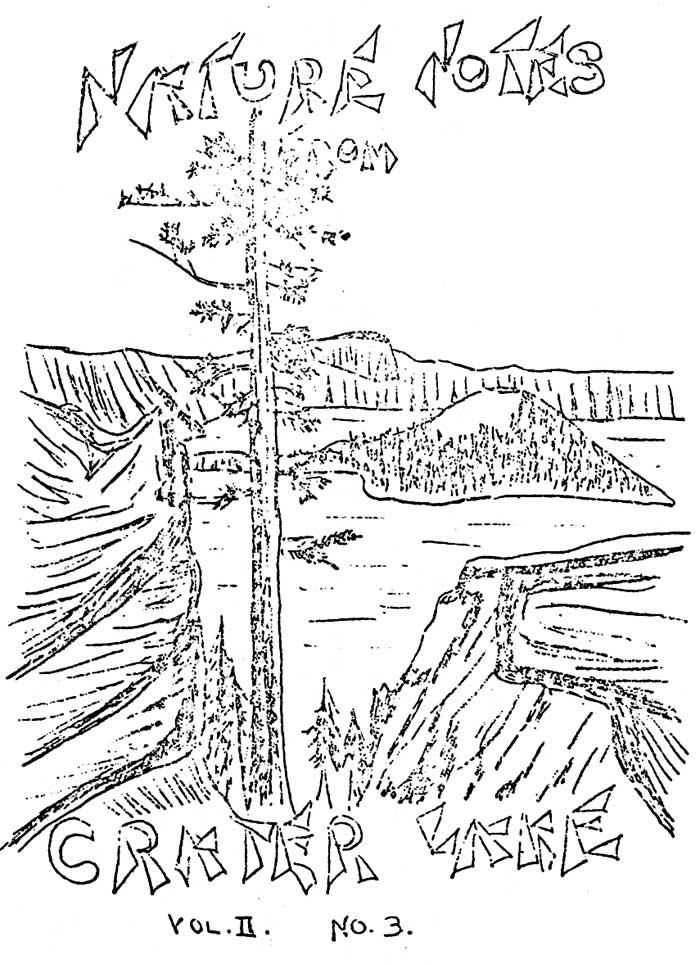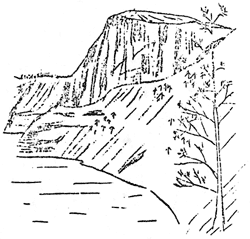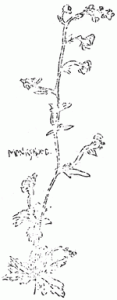Volume 2 No. 3 – September 1, 1929
All material courtesy of the National Park Service.These publications can also be found at http://npshistory.com/
Nature Notes is produced by the National Park Service. © 1929.
An Indian Legend
Many of the prominent cliffs above Crater Lake bear names derived from Indian legends. In 1885, William G. Steel obtained several legends from Allen David, then Chief of the Klamaths.
The stories were not disclosed without some persuasion. Allen David at first refused to divulge any information. A new silver dollar casually seemed to arouse his interest, and a second silver dollar, which to him represented a new trinket, proved to be too great a temptation, and when once he started to talk it was with some difficulty that he was prevailed upon to stop.
According to one legend, many years before the white man came to the region, a band of Klamaths hunting in the forests came upon a lake set deep within a hollow in the mountains. Recognizing it as an abode of the gods they passed silently down the slopes of the mountain and camped far away. One brave, however, returned. He camped upon the very edge of the precipice, slept till morning, then arose and joined the tribe far below upon the mountainside. Again he returned, and each visit bore a greater charm. Voices, mysterious and strange, emanated from the waters. After many moons this brave descended to the water, remained for the night, and again returned to his tribe. Thereafter he spent many night on the lake shore. On these occasions he saw wonderful forms (Llaos, or minor gods) similar to a Klamath Indian except that they lived entirely in the water.
A strange influence came upon this Indian; he was more hardy and stronger than any member of the tribe. Older warriors sent their sons for the strength and courage which were gained by his experience.
On one occasion the youth who first came to the water’s edge captured and killed one of the monsters of the lake. Immediately he was overpowered by countless others who carried him to the great rock which stands above the west shore. His throat was cut with a stone knife and his body torn to pieces and hurled into the water, where it was devoured by other angry Llaos.
While relating this story to Mr. Steel, Allen David held his hands before him, palms inward, thus describing the cliff from which the body of the Indian was thrown. When Mr. Steel later returned to the lake, he recognized the cliff and give it the name Llao Rock, which it bears today.
As told by W. G. Steel to Earl U. Homuth.
More Poison!
The Monk’s Hood or Aconite (Aconitum columbianum) is a very common plant in Crater Lake Park. It is especially common along the streams near Park Headquarters and along the Castle Crest Flower Trail.
Most species of Aconitum are poisonous. One species has long been used in medicine. Cases of human poisoning are largely to be traced to over-doses of the drug used in medicine. Fatality from this plant among animals grazing in the higher altitudes is common. This is another example of the fictitious nature of the popular belief that animals will not eat poisonous plants.
A lethal dose is exceedingly small amounting to only 1/16 of a grain. The effect of poisoning in human beings is first a tingling sensation on the end of the tongue, which shortly gives rise to burning. This is followed by a tingling sensation in the throat. The action of the heart becomes depressed and breathing difficult. Death is caused by a complete stoppage of respiration.
Blyth who has studied records of poisoning in Europe states that there have been cases of murder, suicides, and many more or less accidental deaths. In two of these cases children met death by chewing the flower.
All parts of our species are poisonous but the seeds and roots are especially potent. The exact nature of the lethal substance is not yet known to science, and there is no specific antidote available at the present time. However, physicians have used atropin and amyl-nitrate. Artificial respiration is often necessary during treatment.
From the above, one can readily see the danger which lurks in one of our most beautiful plants.
Pumice and Scoria
By Dale Leslie, Ranger Naturalist
Tourists who are interested in rock collections usually find the display of vesicular lava in the museum at Crater Lake National Park fascinating. These forms of lava are known as pumice stone and volcanic scoria. In physical appearance both are closely related since each is very porous. However, the color of pumice is usually very light while that of scoria varies from red to black. Another relationship may be shown when it is considered that both of these vesicular forms are found on the surface of lava flows.
When hot lavas pour out upon the earth’s surface they are known to contain an abundance of gases as evidenced in the clouds of vapor which arise from them. From the study of scoria and pumice, which are found on the surface of cooled lava flows, it is believed that there is not a complete liberation of all gases since these rocks very porous.
This porosity is probably created by the expansion of gases which are retained in the body of the lava, the expansion being permitted when the extrusive lavas are subject to a release of pressure. The top layers assume a foamy aspect. Upon cooling, the surface lavas maintain this puffed condition and their porosity is in this way explained.
It is interesting to note that the cooled surface lavas known as pumice arose from a very viscous flow, while that lava known as scoria arose from one which was very liquid. The greatest expansion of gases occurring in lava flows occurs in the more liquid types and for that reason scoria has a characteristic spongy appearance. Pumice on the other hand contains many small gas chambers being formed from a viscous rock. Consequently, the porosity is sufficient to allow pumice to float.
At Crater Lake National Park the greatest amount of scoria is found on Wizard Island and pumice is very abundant around the old Crater Rim.





